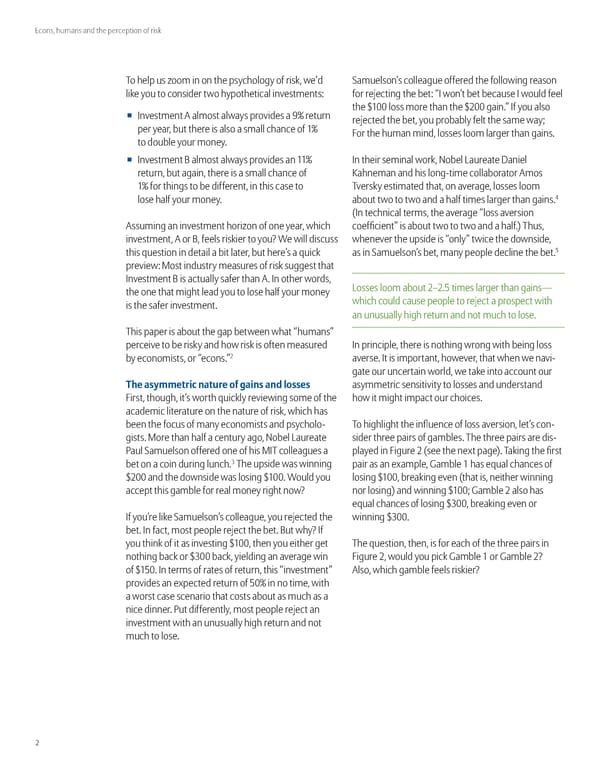Econs, humans and the perception of risk Žo help us žoom in on the psychology of risk, we’d amuelson’s colleague offered the following reason like you to consider two hypothetical investments” for re¥ecting the bet” “„ won’t bet because „ would feel ◾ „nvestment Œ almost always provides a ¡ return the ¤ loss more than the ¤… gain.” „f you also per year, but there is also a small chance of ¡ re¥ected the bet, you probably felt the same way to double your money. For the human mind, losses loom larger than gains. ◾ „nvestment œ almost always provides an ¡ „n their seminal work, ¢obel ›aureate aniel return, but again, there is a small chance of ¦ahneman and his longtime collaborator Œmos ¡ for things to be different, in this case to Žversky estimated that, on average, losses loom lose half your money. § about two to two and a half times larger than gains. ¨„n technical terms, the average “loss aversion Œssuming an investment horižon of one year, which coefficient” is about two to two and a half.© Žhus, investment, Œ or œ, feels riskier to you˜ •e will discuss whenever the upside is “only” twice the downside, this “uestion in detail a bit later, but here’s a “uick as in amuelson’s bet, many people decline the bet.ƒ preview” ‹ost industry measures of risk suggest that „nvestment œ is actually safer than Œ. „n other words, ›osses loom about …–….ƒ times larger than gains— the one that might lead you to lose half your money which could cause people to re¥ect a prospect with is the safer investment. an unusually high return and not much to lose. Žhis paper is about the gap between what “humans” perceive to be risky and how risk is often measured „n principle, there is nothing wrong with being loss by economists, or “econs.”… averse. „t is important, however, that when we navi gate our uncertain world, we take into account our The asymmetric nature of gains and losses asymmetric sensitivity to losses and understand First, though, it’s worth “uickly reviewing some of the how it might impact our choices. academic literature on the nature of risk, which has been the focus of many economists and psycholo Žo highlight the influence of loss aversion, let’s con gists. ‹ore than half a century ago, ¢obel ›aureate sider three pairs of gambles. Žhe three pairs are dis ‚aul amuelson offered one of his ‹„Ž colleagues a played in Figure … ¨see the net page©. Žaking the first £ bet on a coin during lunch. Žhe upside was winning pair as an eample, ‘amble has e“ual chances of ¤… and the downside was losing ¤ . •ould you losing ¤ , breaking even ¨that is, neither winning accept this gamble for real money right now˜ nor losing© and winning ¤ ‘amble … also has e“ual chances of losing ¤£ , breaking even or „f you’re like amuelson’s colleague, you re¥ected the winning ¤£ . bet. „n fact, most people re¥ect the bet. œut why˜ „f you think of it as investing ¤ , then you either get Žhe “uestion, then, is for each of the three pairs in nothing back or ¤£ back, yielding an average win Figure …, would you pick ‘amble or ‘amble …˜ of ¤ƒ . „n terms of rates of return, this “investment” Œlso, which gamble feels riskier˜ provides an epected return of ƒ ¡ in no time, with a worst case scenario that costs about as much as a nice dinner. ‚ut differently, most people re¥ect an investment with an unusually high return and not much to lose.
 Econs, Humans, and the Perception of Risk Page 1 Page 3
Econs, Humans, and the Perception of Risk Page 1 Page 3